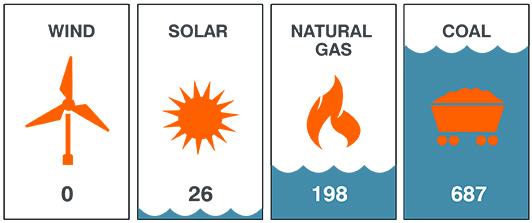6 ways to cut big waste in our energy system
Americans spend $350 billion a year on electricity – three-quarters going to waste – but there are clear solutions.
Apart from the financial burden, such excess contributes to pollution and global warming. Fortunately, there are clear solutions toward a more efficient system – from power plant to plug.
1. Switch to renewable energy
Extracting and burning fossil fuels to produce electricity releases carbon dioxide and other heat-trapping greenhouse gases, as well as local air pollutants. It also yields a lot of waste: Two-thirds of the energy in fossil fuels is lost – vented as heat – at most power plants in the United States.
The so-called "waste heat" is a byproduct of generating the energy, part of the thermodynamic process. The typical power plant burns three units of fuel to generate just one unit of electricity.
Renewable sources, such as wind and solar, burn no fuel and release no greenhouse gases. They are far more effective at converting energy into electricity, keeping waste minimal, while saving money.
The price of large-scale solar (the kind you see in huge arrays in the desert) has fallen 85 percent in the last seven years, and electricity from wind is already cheaper than coal and gas in many places.
2. Pick power sources that use less water

It takes massive amounts of water to convert fossil fuels to electricity. Coal- and gas-fired power plants use water for cooling. During hydraulic fracturing, or “fracking” – a process for extracting oil and natural gas – large quantities of water are mixed with chemicals and sand and injected underground to help draw out the minerals.
Renewables such as wind and solar, however, use negligible amounts of water in turning raw energy into usable electricity.
3. Reduce methane leaks
Cost-effective methods could cut methane leaks in the U.S. by 40 percent – a $100 million yearly savings.
In the U.S., natural gas is one of the most commonly used fuels for electricity. It’s mostly methane – a potent greenhouse gas responsible for about 25 percent of global warming. Leaky equipment across the supply chain has made the oil and gas industry the largest source of methane pollution in the United States.
Oil and gas companies in the U.S. emit at least 9.8 million metric tons of methane pollution a year, according to EPA. Half of all the industry’s methane emissions come from leaks.
There are cost-effective methods available that could reduce leaks by 40 percent – a $100 million yearly savings to the U.S. economy and consumers.

4. Minimize energy loss along wires
Homes and businesses near their energy sources – like with rooftop solar – don’t need to draw from faraway power plants, saving electricity normally wasted in long-distance transmission.
Electricity travels from power plants to communities through high-voltage transmission lines. To reach your home, it must cover long distances, losing power along the way.
Ever notice crackling or buzzing near overhead power lines? That’s wasted electricity. Power plants have to produce more to make up for the loss. The federal government estimates 5 percent of electricity is lost each year in transmission and distribution.
When electricity travels shorter distances, there is less potential for loss. Homes and businesses near their energy sources – like with rooftop solar – don’t need to draw from faraway power plants.
5. Give people only the voltage they need
Electric utilities can install technology, including sensors, to help match customers’ precise energy needs and adjust accordingly.
Studies have shown that customers routinely receive, on average, 2 to 3 percent higher voltage than they need.
Many appliances work just as effectively – yet consume less energy – with a reduced flow of electricity. Higher voltages generally make us waste energy, driving up electricity bills and air pollution.
If your home received the proper voltage for your energy-use needs, you would have enough power to run your appliances efficiently, without wasting electricity. That’s “voltage optimization.” Electric utilities can install technology, including sensors, to help match customers’ precise energy needs and adjust accordingly.
There are pilot programs across the country, and a few utilities have fully adopted the practice. It’s one example of how modern, cost-effective technologies are giving utilities new tools to cut costs and pollution without asking anything of its customers.
6. Boost energy-saving tools for homes
"Smart" appliances and fixtures are using technology to put more energy data – and control – in your hands.
Nationwide energy efficiency standards ensure appliances use less energy and save customers money, which is better for people and the environment.
Innovations in efficiency can relieve stress on the system and cut pollution. “Smart” appliances and fixtures are using technology to put more energy data – and control – in your hands.
For example, the Nest thermostat learns household behaviors and sets temperatures at the optimal levels for comfort and energy savings. A Nest can save 15 percent of electricity consumption from air conditioner usage, the manufacturer says.
Apps on your smartphone or tablet let you manage a host of energy-saving household products, such as washers, dryers, refrigerators, lighting fixtures and more.
Help launch these solutions
We’ve shown you six solutions available today that can reduce wasted energy.
What we need to do now is demand action – from leaders at every level – while urging companies to adopt sustainable business practices.










